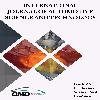The Effect of Injection Parameters on Fuel Consumption and Emissions in A PFI Small Spark Ignition Engine
Mixture formation in port fuel spark ignition engines is one of the most im-portant parameters, which affect combustion and emissions. In this study, the ef-fects of different injection start timings and some other port fuel injection (PFI) parameters on the performance and emissions of a water cooled and single cylin-der spark ignition engine were examined experimentally. The experiments were performed at different engine speeds (1200 and 1500 rpm for effect of injection pressure and 1500 rpm for changing injection timings) and different engine loads (3 bar and 5 bar for injection pressure and 1 bar and 5 bar for start of injection). The start of injection was chosen according to intake pressure measurements. The experiment results showed that brake specific fuel consumption (BSFC) and total hydrocarbon (THC) emissions are increased by the increase of the injection pressure. Because with the increase of injection pressure, the fuel can reach the intake manifold wall or intake valve. Therefore, the fuel enters the cylinder as a droplet. Different start of injection experiments showed that injection times have an effect on emissions and performance. The minimum brake specific fuel con-sumption and THC values were obtained at -243 °CA value of injection start. The twice injection in one cycle increased brake specific fuel consumption and THC emissions.
Keywords:
Spark Ignition Engine Start of injection, Injection Pressure, Break specific fuel consumption, THC emissions,
___
- Heywood, J.B. (1988). Internal combustion engine fundamentals. McGraw-Hill, Newyork.
- Pulkrabek, W. (1997). Engineering fundamentals of the internal combustion engine. Prentice-Hall, New Jersey.
- Nakao, Y., Uchiyama, Y., Hisano, A., Saitou, M. and Sobakiri, K. (2018). Effects of port injection specifications on air-fuel ratio and emission behavior under transient operation. SAE Technical Paper, 2018-32-0012, 1-14.
- Costanzo, V.S. and Heywood, J.B. (2005). Mixture preparation mechanisms in a port fuel injected engine. SAE Technical Paper, 2005-01-2080, 1-15.
- Balki, M.K., Cavus, V., Duran, İ.U., Tuna, R. and Sayin, C. (2018). Experimental study and prediction of performance and emission in an SI engine using alternative fuel with artificial neural network. International Journal of Automotive Engineering and Technologies, 7, 58–64.
- Yontar, A.A. and Doğu, Y. (2018). Flame radius effects on a sequential ignition engine characteristics. International Journal of Automotive Engineering and Technologies, 7, 29–37.
- Yilmaz, I. (2019). Computer aided energy and exergy analysis in compression ignition engines. International Journal of Advances in Engineering and Pure Sciences, 31, 201–207.
- Kim, H., Yoon, S., Xie, X.B., Lai, M.C., Quelhas, S., Boyd, R., Kumar, N. and Moran, C. (2005). Effects of injection timings and intake port flow control on the in-cylinder wetted fuel footprints during PFI engine startup process. SAE Technical Paper, 2005-01-2082, 1-14.
- Meyer, R., Yilmaz, E. and Heywood, J.B. (1998). Liquid fuel flow in the vicinity of the intake valve of a port-injected SI engine. SAE Technical Paper, 982471, 1-21.
- Nogi, T., Ohyama, Y., Yamauchi, T. and Kuroiwa, H. (1988). Mixture formation of fuel injection systems in gasoline engines. SAE Technical Paper 880558, 97-104.
- Zhao, F.Q., Yoo, J.H. and Lai, M.C. (1996). Spray targeting inside a production-type intake port of a 4-valve gasoline engine. SAE Technical Paper, 960115, 1-17.
- Anand, T.N.C. and Ravikrishna, R.V. (2012). Modelling of mixture preparation in a small engine with port fuel injection. Progress in Computational Fluid Dynamics An International Journal, 12, 375-388.
- Kutlar, O.A. (1999). A new method to decrease the fuel consumption at part load conditions of four stroke Otto cycle (Rochas) engine—skip cycle engine. PhD thesis, Istanbul Technical University, Institute of Science and Technology, Turkey.
- Tekeli, Ö. (2013). Designing and production ignition and injection units of a gasoline engine with skip cycle. MsC thesis, İstanbul Technical University, Institute of Science and Technology, Turkey.
- Cheng, C.O., Cheng, W.K., Heywood, J.B., Maroteaux, D. and Collings, N. (1991). Intake port phenomena in a spark-ignition engine at part load. SAE Technical Paper, 912401, 1-13.
- Harrington, J.A. and Shishu, R.C. (1973). A single-cylinder engine study of the effects of fuel type, fuel stoichiometry, and hydrogen-to-carbon ratio on CO, NO, and HC exhaust emissions. SAE Technical Paper, 730476, 1-8.
- Yayın Aralığı: Yılda 4 Sayı
- Başlangıç: 2016
- Yayıncı: Otomotiv Mühendisleri Derneği
Sayıdaki Diğer Makaleler
Sultan SADYKOV, Rinat KHALİMOV, Yesitai KELESHİBİEKE, Sagidolla BATAY, Yong ZHAO
Abdurrahman DEMİRCİ, Hüseyin Emre DOĞAN, Ömer CİHAN, Osman Akın KUTLAR
Ahmet GÜNDEM, Murat HOŞÖZ, Erkan KEKLİK
Gülüstan Tuğçe ALVALI, Ali BALBAY, Serkan GÜNEŞ, Burak YENİPINAR, M. Cem ÇATALBAŞ, Turan ŞİŞMAN
